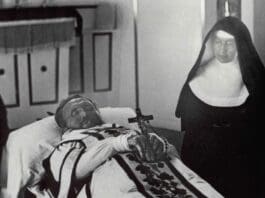
Barbara Cope was born on January 23, 1838, in Southeastern Hessen, present-day Germany. She was the daughter of Peter Cope, a farmer, and Barbara Witzenbacher Cope. Barbara was one of ten siblings. A year after her birth, the Cope family migrated to the United States, settling in Utica, New York, where they joined St Joseph’s Parish and the children attended the parish school.
Despite feeling a strong calling to religious life from a young age, Barbara’s path to her vocation was postponed for nearly a decade due to familial duties. As the eldest child at home, she entered the workforce in a factory after finishing eighth grade to support her family when her father fell ill.
In the summer of 1862, at the age of 24, Barbara embarked on her religious journey, joining the Sisters of St Francis in Syracuse, New York. She received the religious habit on November 19, 1862, adopting the name “Sr Marianne.” The following year, she made her religious profession and began her service as a teacher and principal in various elementary schools across New York State. Originally joining with the intent to teach, Sr Marianne soon found herself in a series of administrative roles.
In the 1860s, Sr Marianne was instrumental in establishing two of the first hospitals in Central New York through her role on the governing boards of her religious community. In 1870, she embraced a new ministry as a nurse-administrator at St Joseph’s in Syracuse, where she excelled as the head administrator for six years. Her intelligence and people skills shone through, especially in her facilitative role, driven by a profound spiritual motivation.
Sr Marianne, known for her kindness and practical wisdom, faced criticism for treating marginalized patients, including alcoholics, but her compassionate care earned her widespread respect and love in Central New York.
In 1883, Sr Marianne’s life took a significant turn when she received a plea for help from the Hawaiian Islands, particularly to assist with leprosy patients. Touched by the request, she eagerly responded, unafraid of the disease and eager to serve. She, along with six other Sisters of St Francis, arrived in Honolulu in November 1883, tasked with managing the Kaka’ako Branch Hospital on Oahu, a facility for patients with Hansen’s disease collected from across the islands.
The Sisters quickly improved the living conditions and treatment of the hospital’s 200 patients. In 1885, they established the Kapi’olani Home within the hospital compound to care for healthy daughters of leprosy patients, a bold decision reflecting their dedication to the stigmatized.
Sr Marianne’s path crossed with Fr Damien de Veuster, known as the “Apostle to Lepers,” in January 1884. She offered him hospitality in 1886 when his diagnosis of Hansen’s disease made him an unwelcome visitor among Church and Government leaders in Honolulu.
The closure of the Oahu Hospital in 1887 by new Hawaiian officials led to a renewed plea for help, to which Sr Marianne responded affirmatively. She arrived in Kalaupapa before Fr Damien’s death, reassuring him of her commitment to the care of his patients.
In Kalaupapa, Sr Marianne, along with Sr Leopoldina Burns and Sr Vincentia McCormick, managed the Bishop Home for Girls and the Home for Boys, facing extreme workloads and challenging conditions. Her never-failing optimism, serenity, and trust in God inspired hope and mitigated the Sisters’ fear of contracting leprosy. Sr Marianne emphasized the duty to make life as comfortable as possible for those afflicted with the disease.
Sr Marianne spent the remainder of her life in Hawaii, never returning to Syracuse. She passed away on August 9, 1918, of natural causes and was laid to rest on the grounds of Bishop Home, leaving behind a legacy of compassionate care.
Photo credit: Public Domain via Wikimedia Commons
The post Saint Marianne Cope appeared first on uCatholic.
Daily Reading
Thursday of the Second Week in Ordinary Time
Reading 1 Hebrews 7:25—8:6 Jesus is always able to save those who approach God through him, since he lives forever to make intercession for them. It was fitting that we…
Daily Meditation
Finding Solace in Jesus
Click here for daily readings “He had cured many, and, as a result, those who had diseases were pressing upon him to touch him” (Mk 3:10). This scene opens with…




